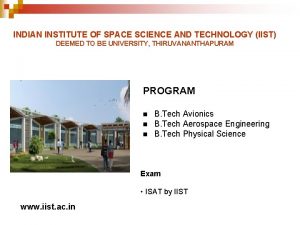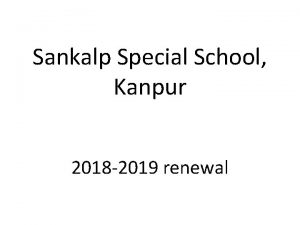Indian Institute of Technology Kanpur India First European

- Slides: 1

Indian Institute of Technology Kanpur, India. First European Space Weather Week, ESTEC, Noordwijk, (The Netherlands), 29 th November-3 rd December 2004. Model Studies on atmospheric ion-induced nucleation of sulfuric acid and water: Interpretation of in-situ measurements Vijay Kanawade, Sanjeev Kumar and S. N. Tripathi Department of Civil Engineering, Indian Institute of Technology Kanpur, India (snt@iitk. ac. in; vijaypk@iit. ac. in) Table 1: Observed and Model predicted particle concentrations for TOPSE Experiment Motivation ØTo develop an efficient and fast ion induced nucleation model, which will be implemented in a global model to study nucleation of particle on global scale. ØTo interpret observed atmospheric nucleation events and to understand the role of cosmic ray induced ionization on particle microphysics. Introduction ØParticle nucleation has been observed in atmosphere that has not been explained by Homogenous Nucleation theory ØIon-induced nucleation is shown to be an effective pathway for explaining new particle formation in the UTLS region (Lee et al. , 2003). Ions are formed by Galactic Cosmic Rays (GCRs) at the rate of 130 ion pairs (Q) cm-3. s-1 in the background lower atmosphere. ØSeveral factors favouring ion-induced nucleation exist in the UTLS region including high sulfuric acid concentration (H 2 SO 4), low temperatures (T), relatively low surface area (SA) of preexisting aerosols, and sufficient sun exposure. Flight/ location Local Time Alt. km Temp. K RH % P (press. ) mb T[H 2 SO 4] 106 cm-3 SA Q Flight 16 1330 4. 2 240. 1 5. 6 573. 0 9. 21 15 10 65 289 3361 56 256 3031 (within SO 2 Plume) Flight 16 ( Above Plume) 1330 4. 2 4. 1 4. 3 241. 2 237. 9 240. 0 5. 3 4. 9 5. 5 4. 6 574. 4 574. 6 519. 6 548. 1 9. 19 8. 24 1. 85 3. 88 15 15 10 10 20 5 0. 01 80 10 0. 06 2324 2021 137 830 29 11 4 8 135 33 14 21 1889 1567 78. 0 230. 0 Max. Observed particle number conc. cm-3 3 -4 nm 3 -8 nm >3 nm Model Predicted particle number Conc. cm-3 3 -4 nm 3 -8 nm >3 nm T[H 2 SO 4]= Observed H 2 SO 4 plus Calculated H 2 SO 4 ; (H 2 SO 4 calculated with the observed SO 2 and OH concentration by using rate limiting reaction OH + SO 2= H 2 SO 4 (De. More et al. , 1997)) Model ØIon induced nucleation parameterization based on Kinetic model (SAWNUC) (Lovejoy et al. , 2004) is implemented in the H 2 SO 4 -H 2 O Aerosol Microphysical model (SAMIN) (Tripathi et al. , 2004). ØNucleation parameterization is valid in the ranges: 200≤T≤ 280 K, 5≤Relative Humidity(RH)≤ 95%, 105 ≤H 2 SO 4 ≤ 108 molecules. cm-3, 2 ≤SA≤ 200µm 2. cm-3, and 2≤Q≤ 30 ion pairs cm-3. s-1. ØBesides ion induced nucleation (IIN), SAMIN simulates H 2 SO 4 condensational growth, water vapour equilibrium, particle-particle coagulation and sedimentation. ØThe particle size range in the SAMIN model covers particles having radii between 0. 3 nm to 1. 0 µm. The size range is geometrically divided into 40 bins and integration time step used is 60 seconds. SAMIN and SAWNUC predicted aerosol size distributions for the enviormental codition T=236 K, RH=4%, SA=15 µm 2. cm-3, Q=12 ion pairs cm-3. s-1 for different H 2 SO 4 gas concentration is presented in Figure 1(a, b, c). It can be seen that SAMIN and SAWNUC predicted aerosol size distributions are in good agreement. Figure 3(a) Figure 3. (a) 2 -day Back Trajectory plot for air parcel height, T and RH during TOPSE experiment. (b) Comparison between observed and model predicted UCN>3 nm for the observed environmental parameters during TOPSE experiment. (c) Sensitivity test for preexisting particle surface area on ultra fine particle (3 -4 nm) during TOPSE experiment. Figure 4(a) (b) (c) Figure 1(a, b, c). Comparison between SAMIIN model and SAWNUC model predicted aerosol size distribution for different sulfuric acid gas cocnetrations. Model Predictions (b) Figure 2. (a, b): SAMIN predicted particle size distribution curve and particle production for environmental condition within UTLS region. Figure 4(c) Figure 4(b) Figure 4. (a) Comparison between observed and model predicted ultra fine particle (3 -4 nm) for PEMT A experiment flight 10. (b) Comparison between observed and model predicted UCN>3 nm for PEMT A experiment. flight 10. (c) Comparison between observed and model predicted ultra fine particle (3 -10 nm) for ACE 1 experiment. Flight 17. Table 2: Observed and model predicted particle number concentration for atmospheric Nucleation events PEM Tropics A (Pacific Exploratory Mission in the Tropics-Phase A) Evolution of the size distribution of particle predicted by the model for a typical environmental condition within UTLS region is plotted in the Fig. 2(a, b). Figure 2(a) shows the particle growth from 3 nm to 100 nm for 40 hr. model run. Figure 2(b) depicts the evolution of size distribution for radius range from 0. 3 nm to 100 nm over a 24 hr. period. The model run was from sun rise until sunset to predict size distribution of aerosol particles. (a) Figure 3(c) Figure 3(b) Interpretation of Observed Nucleation Events SAMIN was run using measured environmental parameters e. g. T, RH, H 2 SO 4, SO 2 (Sulfur dioxide, pptv), OH, to interpret different observed atmospheric nucleation events viz. , (i) TOPSE (Tropospheric Ozone Production about the Spring Equinox), (ii) ACE-1 (First Aerosol Characterization Experiment-One), (iii) PEM Tropics A (Pacific Exploratory Mission in the Tropics-Phase A), (iv) PEM Tropics B (Pacific Exploratory Mission in the Tropics-Phase B), (v) TRACE P (TRAnsport and Chemical Evolution over Pacific) TOPSE (Tropospheric Ozone Production about the Spring Equinox) Table 1 summarizes the observed environmental parameters during TOPSE experiment, where in-situ new particle production were observed. We have calculated new particle production (3 -4 nm, 3 -8 nm) for the observed environmental parameters, by running the model from sunrise until the observation time (see Table 1). The direct comparison between the model predicted and observed Ultra fine Condensation Nuclei (UCN)>3 nm is problematic because the history of the air parcel containing the fresh ultra fine particles as well as aged particles is uncertain and also temperature and relative humidity is changing along the path of air parcel. To interpret UCN >3 nm, we have computed back trajectory of the air parcel using HYSPLIT model for TOPSE flight 16 observed environmental parameters (Figure 3(a)) and SAMIN model run for 2 days with these HYSPLIT calculated T and RH to interpret on UCN>3 nm. Flight/ location Local Time Alt. km Temp. K RH % P mb T[H 2 SO 4] 106 cm-3 SA Q Max. Obs. Particle particle conc. cm-3 3 -9 nm Model Predicted Particle conc. cm-3 3 -9 nm Flight 10 1300 4. 9 273. 2 74. 5 671. 1 10. 5 15. 0 10 382. 0 272. 0 1800 -1900 8. 3 249. 8 55. 3 433. 6 3. 89 15. 0 10 1568 1038 ACE 1 (First Aerosol Characterization Experiment-one) Flight/ location Local Time Alt. km Temp. K RH % P (press. ) mb T[H 2 SO 4] 106 cm-3 SA Q Flight 16 1600 -1700 5. 5 254. 5 62. 5 505. 5 3. 12 15. 0 10 350 194 6. 1 250. 0 55. 0 480. 4 2. 68 15. 0 10 230 105 Flight 17 1600 -1800 3. 2 262. 5 686. 6 7. 66 15. 0 10 2117 2188 Flight 27 1200 -1400 3. 6 265. 5 67. 7 650. 5 7. 68 15. 0 10 350 260 PEM Tropics B (Pacific Exploratory Mission in the Tropics-Phase B) Flight/ Local Alt Temp RH P T[H 2 SO 4] location Time km deg. K % mb 106 cm-3 Flight 13 1130 -1230 0. 2 0. 3 295. 3 288. 4 78. 3 67. 7 990. 2 975. 5 26. 3 47. 8 SAa 15. 0 Max. Obs. Particle Conc. cm-3 3 -10 nm Model Predicted Particle Conc. cm-3 3 -10 nm Qb Max. Obs. Particle Model Predicted Particle Conc. cm-3 3 -4 nm 3 -10 nm 3 -4 nm 3 -10 nm 10 8. 0 230 0. 0 10 13. 0 376 0. 8 9. 0 Conclusion: ØIt was found that SAMIN predicted ultra fine particle (3 -4 nm, 3 -8 nm, 3 -10 nm) number concentrations are in good agreement with the observed one during different nucleation events in the middle and upper troposphere. Also UCN>3 nm number concentration is also matching quite well with the observed one during TOPSE experiment. ØWe conclude that ion induced nucleation play key role in the formation of ultra fine particles in the cold middle and upper troposphere (~4 -7 km) for a range of parameters T=235 -280 K, RH=466%, H 2 SO 4=2'106 -9'107 molecules. cm-3, SA=2 -200μm 2. cm-3 and Q=2 -30 ion pairs cm-3. s-1, for which SAMIN is able to predict observed new particle formation. Future Work ØPresent aerosol microphysical model is being modified to study the effect of ions on particle formation, which activates into cloud condensation nuclei and to study cloud microphysics. References: 1. De. More, W. B. , S. P. Sandar, D. M. Golden, R. P. Hampson, M. J. Kurylo, C. J. Howard, A. R. Ravishankar, C. E. Kolb, and Molina, Chemical kinetics and photochemical data for use in stratospheric mo 0 deling, JPL Publ. , 97 -4, 1997 2. Modgil, M. S. , Kumar, S. , Tripathi, S. N. , and E. R. Lovejoy, A Parameterization of Ion Induced Nucleation of Sulphuric Acid and Water for Atmospheric Conditions, Under review. J. Geophys. Res.

